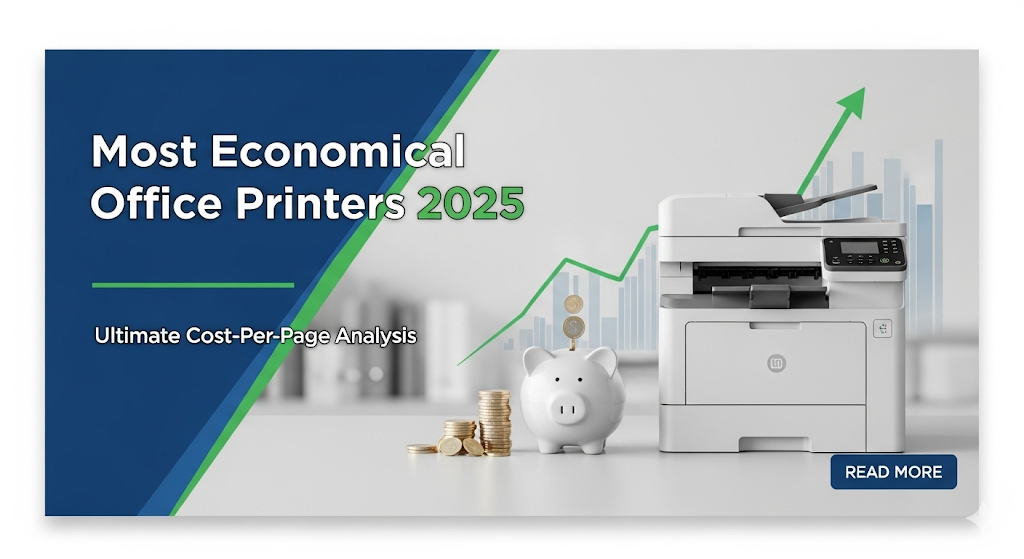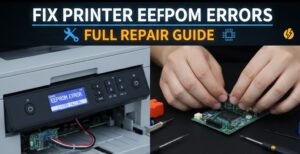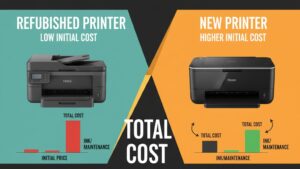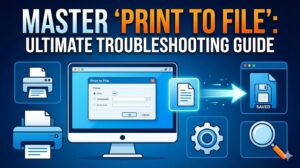Introduction
Finding the most economical office printers 2025 has to offer requires looking beyond sticker prices to understand true printing costs. Smart businesses analyze cost-per-page metrics to identify printers that deliver maximum value over their operational lifespan.
Hidden costs like expensive ink cartridges, frequent maintenance, and energy consumption can turn an affordable printer into a budget nightmare. The cheapest upfront option often becomes the most expensive long-term investment without proper cost analysis.
This comprehensive guide reveals the most cost-effective office printers available in 2025, complete with detailed cost-per-page breakdowns. We’ll show you how to calculate true printing costs and identify the best value printers for your business needs.
What Is Cost-Per-Page Analysis for Office Printers?
Cost-per-page analysis calculates the total expense of printing each page, including consumables, maintenance, energy, and equipment depreciation. This metric provides the most accurate comparison between different printer models and technologies.
The calculation includes toner or ink cartridge costs divided by page yield, plus paper costs, maintenance expenses, and energy consumption per page. Many businesses overlook these hidden costs when making printer purchasing decisions.
Professional cost-per-page analysis also factors in equipment lifespan, warranty coverage, and productivity losses from downtime. The most economical office printers 2025 businesses choose excel in all these areas, not just consumable costs.
Monochrome printing typically costs 2-4 cents per page, while color printing ranges from 8-15 cents per page depending on technology and usage patterns. Understanding these benchmarks helps identify truly economical printing solutions.
7 Proven Methods to Identify the Most Economical Office Printers
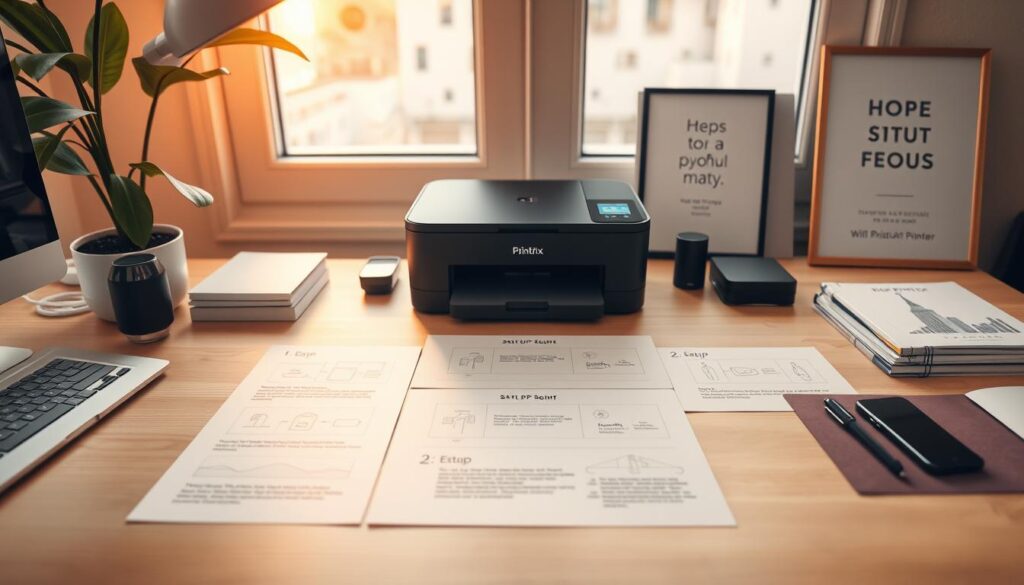
1. Calculate True Cost-Per-Page Including All Variables
Start by gathering accurate data on cartridge costs, page yields, and replacement frequency for each printer model you’re considering. Include both black and color cartridge expenses in your calculations.
Add paper costs, which typically range from 1-2 cents per page depending on quality and volume purchasing. Don’t forget maintenance supplies like drums, fusers, and cleaning kits required for laser printers.
Factor in energy costs based on the printer’s power consumption during operation and standby modes. Energy-efficient models can save $50-200 annually in electricity costs alone.
2. Compare High-Yield vs Standard Cartridge Economics
High-yield cartridges often provide 50-100% more pages at only 20-40% higher cost, dramatically reducing per-page expenses. Calculate the cost difference to identify the most economical approach.
The most economical office printers 2025 models support high-yield cartridges that minimize cartridge changes and administrative overhead. This becomes crucial for high-volume printing environments.
Consider subscription services that automatically deliver cartridges at discounted prices. Many manufacturers offer significant savings through these programs.
3. Evaluate Duplex Printing Capabilities
Automatic duplex printing cuts paper costs in half for many document types while supporting environmental initiatives. This feature alone can save hundreds of dollars annually in busy offices.
Look for printers with fast duplex speeds that don’t significantly slow down printing workflow. Slow duplex printing frustrates users and reduces productivity benefits.
Calculate paper savings based on your typical document types. Reports, contracts, and internal documents work well for duplex printing, while presentations often require single-sided printing.

4. Analyze Monthly Duty Cycle vs Your Actual Volume
Choose printers with duty cycles significantly higher than your monthly volume to ensure reliable operation and extended lifespan. Overworked printers fail prematurely and require expensive repairs.
The most economical approach uses 25-50% of the printer’s maximum duty cycle. This provides optimal reliability while maximizing equipment lifespan and minimizing maintenance costs.
Consider seasonal variations and business growth when calculating volume requirements. Peak periods shouldn’t push equipment beyond recommended limits.
5. Research Third-Party Cartridge Compatibility
Compatible cartridges can reduce printing costs by 40-70% compared to original manufacturer cartridges. Research quality and warranty implications before making this switch.
Some printer models work better with third-party cartridges than others. Read reviews and test small quantities before committing to large purchases.
Factor in potential warranty issues if third-party cartridges damage the printer. Some manufacturers void warranties when non-original cartridges are used.
6. Consider Toner vs Inkjet Technology Economics
Laser printers typically offer lower per-page costs for high-volume printing, while inkjet models can be more economical for low-volume color printing needs.
Toner cartridges have longer shelf life and don’t dry out like ink cartridges, making them ideal for irregular printing patterns common in many offices.
Modern inkjet technology has improved significantly, offering competitive per-page costs with better color quality than laser printers for graphics and photos.
7. Factor in Productivity and Downtime Costs
Reliable printers minimize costly downtime and frustrated employees. Calculate the value of lost productivity when printers fail during critical business periods.
The most economical office printers 2025 professionals recommend balance low operating costs with proven reliability records. Cheap printers that break frequently aren’t economical.
Consider print speeds and first-page-out times that affect user productivity. Slow printers waste employee time, which costs more than supply savings.
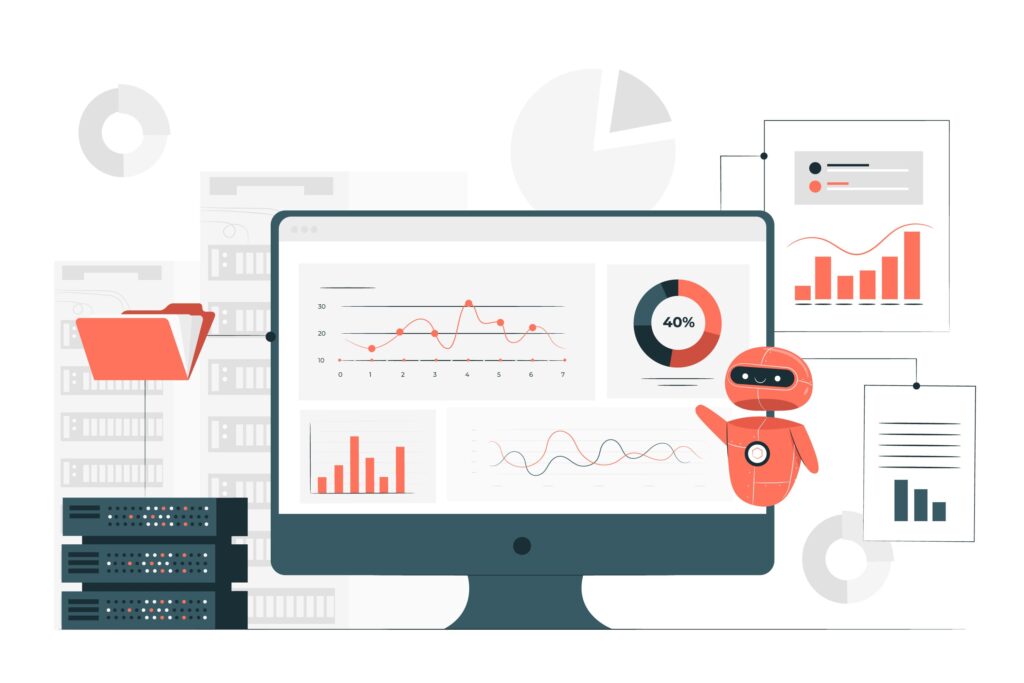
Advanced Cost-Analysis Tools and Techniques
Print management software provides detailed usage analytics that help optimize printing costs across your organization. These tools identify wasteful printing habits and enforce cost-saving policies automatically.
Fleet management systems track costs across multiple printers, helping identify the most and least economical models in your current setup. This data guides future purchasing decisions.
Online cost calculators from manufacturers and independent sources help compare total cost of ownership between different printer models. Use multiple calculators to verify results.
Managed print services can provide cost predictability through fixed monthly fees that include equipment, supplies, and maintenance. This approach works well for businesses wanting predictable printing budgets.
Common Cost-Analysis Mistakes That Waste Money
Focusing only on purchase price while ignoring operating costs leads to expensive mistakes. A cheap printer with expensive cartridges costs more over its lifetime than a quality printer with economical supplies.
Overbuying printer capacity for actual needs wastes money on unused features and higher operating costs. Right-sizing equipment to actual usage provides better economics.
Ignoring cartridge yield specifications when comparing costs creates inaccurate analysis. Always compare cost-per-page rather than cartridge prices to get meaningful comparisons.
Failing to negotiate volume discounts on cartridges and supplies misses significant savings opportunities. Bulk purchasing or annual contracts often provide 10-30% savings.
Not considering printer lifespan in cost calculations undervalues reliable equipment. A printer lasting 5 years costs less annually than one requiring replacement after 2 years.
Overlooking energy costs becomes expensive over time, especially for always-on office printers. Energy Star certified models provide measurable savings on electricity bills.
Buying printers without considering actual paper handling needs leads to productivity losses. Inadequate paper capacity or finishing options reduce efficiency and increase labor costs.
Frequently Asked Questions
Q: What’s considered a good cost-per-page for office printing? A: Excellent monochrome printing costs under 2 cents per page, while color printing under 8 cents per page represents good value in 2025 market conditions.
Q: Do laser printers always cost less per page than inkjet printers? A: For high-volume printing, laser printers typically offer better economics. For low-volume color printing, modern inkjet printers can be more economical per page.
Q: How often should I calculate printing costs? A: Review printing costs quarterly and recalculate annually when supply contracts renew or when considering new equipment purchases for accurate budgeting.
Q: Are subscription ink services worth the cost? A: Subscription services often provide 20-40% savings on cartridges while ensuring you never run out of supplies, making them economical for most businesses.
Conclusion
Identifying the most economical office printers 2025 requires comprehensive cost-per-page analysis that goes beyond purchase prices to examine total ownership costs. Smart businesses invest time in proper analysis to avoid costly mistakes that impact budgets for years.
The most economical approach balances low operating costs with reliable performance, appropriate capacity, and features that enhance productivity. Cheap printers that break frequently or waste employee time aren’t truly economical solutions.
Use the strategies and tools outlined in this guide to make informed decisions that optimize your printing budget while meeting business needs effectively. Remember that the lowest cost-per-page printer isn’t always the best choice if it lacks essential features.
Regular cost analysis and optimization ensure your printing infrastructure continues delivering maximum value as technology evolves and business needs change throughout 2025 and beyond.
Best Laser Printers High Volume Office: Ultimate Guide for Busy Workplaces Read More.

